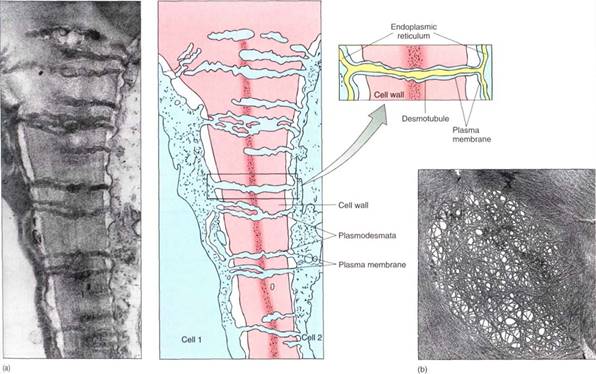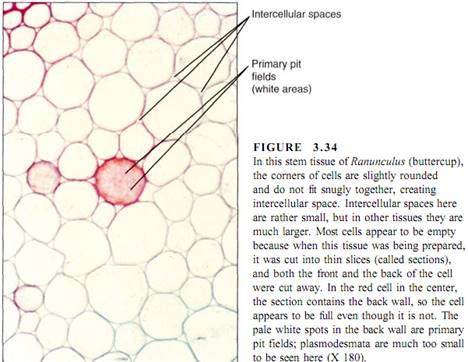


 النبات
النبات
 الحيوان
الحيوان
 الأحياء المجهرية
الأحياء المجهرية
 علم الأمراض
علم الأمراض
 التقانة الإحيائية
التقانة الإحيائية
 التقنية الحيوية المكروبية
التقنية الحيوية المكروبية
 التقنية الحياتية النانوية
التقنية الحياتية النانوية
 علم الأجنة
علم الأجنة
 الأحياء الجزيئي
الأحياء الجزيئي
 علم وظائف الأعضاء
علم وظائف الأعضاء
 الغدد
الغدد
 المضادات الحيوية
المضادات الحيوية|
Read More
Date: 19-10-2016
Date: 7-11-2016
Date: 27-10-2015
|
Fungal Cells
Cells of fungi are similar to plant cells, with two important differences: (1) They do not contain plastids of any type, and (2) their walls contain chitin, not cellulose, except for one unusual group of fungi, the Oomycetes. Chitin is physically similar to cellulose, being tough, inflexible, and insoluble in water, but it contains nitrogen and is synthesized by a different mechanism than that used for cellulose.
ASSOCIATIONS OF CELLS
In unicellular organisms, such as simple algae, protozoans, and most bacteria, each cell is a complete organism and does not interact directly with other cells. Such cells can communicate indirectly, at least to a small extent, by releasing chemicals that affect the other cells, but such interactions are rare, usually occurring only during the attraction of other cells during sexual reproduction.
In multicellular organisms each cell automatically, unavoidably interacts with its neighboring cells; they must share the same sources of photosynthate, oxygen, carbon dioxide, salts, and water. Whereas a unicellular organism can merely excrete its wastes across its plasma membrane, cells of a multicellular organism are not so free to do so.
Just as important are cellular interactions by which cells not only sense that they are part of a larger organism but also identify which part they are and how they should differentiate. In a developing embryo, the proper cells must be instructed to begin forming an embryonic shoot while other cells are induced to form the embryonic root, vascular tissues, seed leaves, and so on. This requires extensive, sophisticated intercellular communication. One communication method is like that used by unicellular organisms: A cell secretes specific compounds that "inform" the surrounding cells of what it is doing metabolically and developmentally. A second method is connections between the cells. Direct physical contact between cells, as exists in animals, cannot occur in plants because the two primary walls and middle lamella are located between any two adjacent protoplasts. However, plant cells are interconnected by fine holes (plasmodesmata; sing.: plasmodesma) in the walls (Fig. 3.33). A plasmodesma is only about 40 nm in diameter, but the plasma membrane of one cell passes through it and is continuous with the plasma membrane of the adjacent cell. A small channel of cytosol also passes through, as does a short section of specialized ER.


The abundance of plasmodesmata in a wall is quite variable; they can occur singly or in clusters of 10 to 20 or more. In regions of clustered plasmodesmata, the two primary walls are often particularly thin, and the area is called a primary pit field (Fig. 3.33b). In tissues in which considerable transport occurs (into glandular or conducting cells), many primary pit fields and plasmodesmata are present, but in regions where little movement of material happens, few plasmodesmata are found(Table 3.9). Because plasmodesmata are actually cytoplasmic channels from one protoplast to another, the individuality of the cells is diminished; all the protoplasm within a single plant is part of one interconnected mass, the symplast. In some of the nutrient-conducting tissues and also in some of the reproductive tissue, plasmodesmata are so large and numerous that the cells act more like one single large cell than like individual cells. In most tissues, however, any two adjacent cells act rather independently; the communication through the plasmodesmata is not enough to prevent individuality.

The fact that walls keep protoplasts physically separated from each other has another consequence. Walls act as a second, nonliving compartment inside plants. Water moves through cell walls by capillary action, just as it moves through tissue paper. In addition, many cells do not about each other tightly but instead have intercellular spaces between them, at least at their corners (see Fig. 3.34). In some tissues, especially leaves, cells are so loosely connected that most tissue volume is intercellular space; less than half is actually symplast. These spaces plus the cell wall constitute the apoplast; the apoplast and the symplast together make up the whole plant. The apoplast acts as a series of channels and spaces that permit the rapid diffusion of gases, which is necessary because plants do not have lungs. Diffusion through a gas-filled space is approximately 10,000 times faster than through a liquid-filled space. Without an apoplast, large, bulky plant tissues such as tree trunks, tubers, and fruits would be impossible; the interior tissues would suffocate.




|
|
|
|
إجراء أول اختبار لدواء "ثوري" يتصدى لعدة أنواع من السرطان
|
|
|
|
|
|
|
دراسة تكشف "سببا غريبا" يعيق نمو الطيور
|
|
|
|
|
|
قسم الشؤون الفكرية يقيم برنامج (صنّاع المحتوى الهادف) لوفدٍ من محافظة ذي قار
|
|
|
|
الهيأة العليا لإحياء التراث تنظّم ورشة عن تحقيق المخطوطات الناقصة
|
|
|
|
قسم شؤون المعارف يقيم ندوة علمية حول دور الجنوب في حركة الجهاد ضد الإنكليز
|
|
|
|
وفد جامعة الكفيل يزور دار المسنين في النجف الأشرف
|